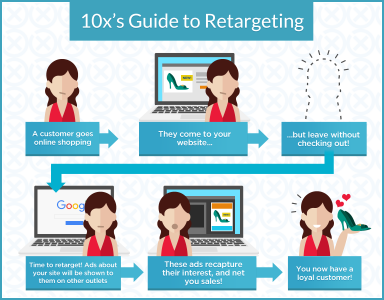If you are a marketer, you think your prospects take a very linear path to purchasing products or services. In an ideal world consumers perform a Google search for a keyword associated with a business, a Google ad pops up in the top three search results, they click on it and make the purchase pronto! In reality, however, this is likely not your buyer’s journey. Actually, only a staggering 2 percent of the people who visit your site actually convert! So how do you reach the other 98 percent? In a digital world, retargeting your audience is one of the most important marketing tactics you can implement.
Retargeting vs. Remarketing
First and foremost, it’s necessary to understand the distinction between these two terms. Remarketing can take on many forms—phone calls, mailing lists etc.—yet the primary vehicle used today is email. In its simplest form, retargeting is a form of remarketing by utilizing online ads to go after the same traffic again and again. As Hubspot defines it, retargeting will always live in the realm of PPC and display network advertising.
Set Your Goals
Are you looking to simply make prospects aware of your business, or are you looking for specific people to click on your ad and take action? Conversion campaigns are much more targeted and arguably more effective—but it all depends on the goals you set from the beginning and what makes sense for your business. If you’re a healthcare practice advertising your rebrand, an awareness campaign makes more sense than measuring for conversions. Often an awareness campaign is a good stepping-stone to set up for a conversion campaign.
Pixel-based Retargeting
This form of retargeting is the most common. When someone visits your website, they are ‘tagged’ through JavaScript code (or pixel) worked into the code of your website. Your visitors are ‘cookied’ upon arrival, allowing your retargeting vendor to advertise to them when they browse other websites. If you’ve ever been online shopping but did not make a purchase, you’ve more than likely experienced this form of retargeting.
This Infographic guides you through the process and shows how it can easily work for you to start converting visitors into customers:

Pixel-based retargeting is a great for immediately targeting individuals after leaving your website. However, since it’s based on how often consumers are coming to your website and then leaving, there is lower volume of people being measured at any given moment.
List-based Retargeting
If you are fortunate enough to have a large database of contacts, this method of retargeting could work for you. It’s highly customizable because it’s based on more than just one behavior. You can upload your list of email addresses to a retargeting campaign—usually on social networks such as Facebook. The platform then identifies those users via their email address and advertises to them. Unfortunately, this method can sometimes be less effective due to the time it takes to manage the list and the chance that users on your list are utilizing different email addresses for their social accounts.
Segment, Segment, Segment
The behavioral data you can gather from your website visitors should never be taken for granted when building a retargeting campaign. It’s important to segment your visitors so you can customize the ads you show to them based on their position in your sales funnel. We asked our Paid Search Specialist to weigh in on this important aspect of retargeting:
“Granular audience segmentation is so vital to a remarketing campaign’s success. Knowing the purchase behavior of each particular audience helps you craft the most relevant and purchase driven ads.” Timothy Wilkins
Never Stop Optimizing
The beauty of all digital advertising campaigns is that we have the power to optimize them until we find the most effective ads. We don’t have to wait until the campaign is over and the budget has been used to realize we could’ve done a better job. Continue to A/B test your retargeting ads for size, type of content and value proposition. In addition, switch up the creative to keep your audience engaged and to ensure you’re delivering the strongest message while still hitting your goals for the campaign.
Once you get the hang of retargeting your past website visitors, you can experiment with more advanced retargeting, such as people who visit your competitor’s site but have never visited yours. We’ll explore this next method in a later blog post!

